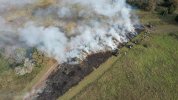I had one get away from me. It was pretty cool out, say in the 40s, dead calm and seemed like the humidity was relatively high. I had about 5 acres of chest high grass/weeds. I had disced it up and grown a pumpkin patch and some summer food plots, cowpeas and stuff and it really got out of hand with weeds. This was in like February. I was going to burn a small chunk and disced in a break. There didn't seem to be any wind so I didn't think I could really back fire. The grass was kind of hard to get started with matches, I didn't have a drip torch. Fast forward 30 min, grass was burning like 8 foot high, jumped the fire break caught all 5 acres on fire. Fire was so big and hot that it made its own wind, it was like a fire tornado. I was terrified it was going to leave my property which was only about 40 acres with a lot of big cedars. Fire department came, I lost some implements. Caught the tires on fire on my plow and disc. Nearly lost my good tractor. I got a lecture from the chief for being an idiot. No charge no consequences. This was in rural central Missouri where you can do what you want. Now I'm in SW Missouri in the Ozarks and I have hundreds of acres of timber I'd love to have a slow burn run through but I wouldn't touch it with a 10 foot pole now, lol.
The grass never came back so thick and lush, went from war zone to the green hills of Ireland in three weeks. It also killed a ton of rabbits and mice and birds and box turtles on the negative side.
The grass never came back so thick and lush, went from war zone to the green hills of Ireland in three weeks. It also killed a ton of rabbits and mice and birds and box turtles on the negative side.
Last edited:


